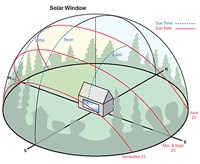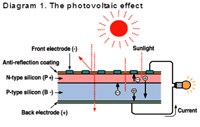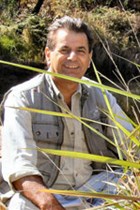A silent revolution is taking place in the world of electrical energy - and few people are fully aware of its potential.
Architects, homeowners, financial decision makers, business owners, and even electrical engineers have not fully grasped how the solar energy scene is changing.
And it's changing fast.
The price of quality electrical components is dropping, even as Eskom prices continue to rise. This means that for an increasing number of applications, solar electric or photovoltaic power is now making perfect financial sense.
We keep hearing about solar water heaters and heat pumps, yet few think about generating their own electricity using photovoltaic power. But this technology is fast emerging into the light.
When photovoltaic power is mentioned, it's immediately written off as unrealistic and too costly. But the wheel turns and for many reasons which I unpack below, it's now becoming more viable and proven in the field.
What is photovoltaic power? This is where a silicone-based solar (photovoltaic) panel converts sunlight directly into electricity.
On a sunny South African day one photovoltaic panel of 1m² can generate around 1KW of electrical energy, enough to boil a kettle of water in two minutes. This is astounding and proves the extremely high solar radiation we enjoy at this southern tip of Africa.
This is quite different to a solar water heating panel which contains water heated by the sun. The dual use of the term 'solar panel' is what confuses most non-technical people.
The truth is too few are capitalising on the phenomenal power of our African sun to generate electric power.
But it's happening. Take a look.

Array of photovoltaic panels supplying all the electric power to a Gauteng school.
Not many people realise for example that there exists a primary school on the East Rand that operates purely on solar energy ... it doesn't even have a power line from Eskom.
This is energy security and energy independence at its best. The array of photovoltaic (PV) panels powers the whole school during the day and there is a small battery bank to run the operation when the sun no longer shines. These batteries are themselves charged by sunlight, and work like a large UPS back-up system, supplying after-hours power to such items as lights, security system and computers.

Blue inverters to power the 3-phase solar powered school.
Electrical engineer Alastair's system is similar in principle to those small garden LED lights with a small photovoltaic panel on the top. During the day sunlight charges the batteries via the small photovoltaic panel. At sundown these fully charged batteries then power the light throughout the night.
Why did the owner of this school opt to go this photovoltaic route?
There are many reasons.
Benefits of a well-designed photovoltaic system:
a) Cheaper than Eskom, especially in the medium to long term.
b) A fairly high capital investment but a short payback period of 1.9 years, thereafter totally free electricity from the sun.
c) A saving over 20 years of over R3m!
d) A performance warranty of 20 years or more (Service Level Agreement)
e) Energy security and energy independence. An asset in itself.
f) Immunity from future Eskom price increases
g) Immunity from Eskom power outages
h) Increased value of the 'green' property. (+5-10% according to the American Appraisal Institute)
i) A low carbon footprint/tax and compliance with environmental ethics.
j) Totally silent system with low maintenance
k) aesthetically acceptable panels, especially when mounted flush on a north-facing roof
l) Virtually zero running costs once the capital has been repaid.
m) PV as a market differentiator. 'Green' businesses simply sell better.
n) A financial no-brainer!
The beauty of a green design:
Any technician with a bakkie can install panels on your roof, but if the entire energy picture is not taken into consideration, it can be a costly, unreliable affair. This is why a 'green rational design' is so important. In fact system design is critical to reliability and to cost-effectiveness.
The problem is that true specialists are few and far between ... engineers capable of integrating the multi-level parameters, able to design cost-effective, reliable photovoltaic systems.
If such specialist engineers exist, then ladies and gentlemen please stand up and be counted, for your time has arrived!
One 'green' electrical engineer Alastair is already standing, and like a surfer he's beginning to ride the solar energy wave. On Google map he monitors his growing number of off-grid and grid-interactive photovoltaic installations. These he monitors remotely and wirelessly. The installations are in the form of blue PV icons on his map.
Off-grid means zero Eskom power, while grid-interactive (or grid-tied) means Eskom is used only as back-up. Grid-interactive is often a most practical, cost-effective compromise, certainly cheaper than batteries and less noisy and smelly than diesel generators.
If the PV icon on Alastair's Google map changes from blue to red he knows, even before his client does, that attention is needed. He can not only diagnose issues remotely, but can solve many problems from his mobile laptop. But to date he's only seen blue PV icons spreading across his Gauteng map! PV Systems, especially when intelligently designed, are virtually zero-defect, highly reliable systems.
'Rational green designs'
His marketing thrust is now aimed more at financial decision makers and business owners rather than at technical decision makers. He has already demonstrated the viability of his systems to previously sceptical, heavy-weight electrical engineers. And his secret lies in what he terms his 'rational green designs'.
Due to economies of scale Alastair's designs are financially more attractive to the commercial rather than to the residential sector where the payback period is slightly longer. However his domestic designs remain highly effective and owners are more than satisfied with their energy independence. The reality is that most commercial businesses operate mainly during the day, and a PV system can take the company off Eskom power to a lesser or greater degree. PV can power all appliances including air-conditioners, computers, copiers, lights, security systems and more. If more power is needed, then more panels are simply installed on the roof and inverters reprogrammed to power assist.
Before he installs any solar power generating system Alastair first takes a good look at the establishment. As every building is different, he does a site assessment for solar orientation plus a load assessment.
In order to design the system correctly Alastair compiles and delivers an initial 'Sustainability and Energy Analysis Report'. He calculates countless variables including solar orientation and what sort of loads to which his PV system will be subjected.

Solar energy modelling throughout all four seasons.
click to enlargeBefore designing his solar generating system, Alastair never fails to addresses the building's passive energy aspects. For example how can energy inefficiencies be minimised or eliminated?
Insulation, which is comparatively cheap, is a good example of how to manage passive energy intelligently. A well-insulated, well-ventilated building does not get hot from the sun (solar gain) meaning air-conditioners need to work less, if at all. And if the building is able to warm itself in winter (through solar gain), then heaters are unnecessary.
Lighting is also addressed. Together these are big consumers of electrical energy, particularly in a commercial environment.
When these factors are taken into consideration, the result is a financially attractive, reliable, highly sustainable on-roof photovoltaic solution!
Only once the buildings energy profile has been calculated, does Alastair design his PV system for optimum performance. This can be in either single or three phase, depending on the load. Peak loads are also taken into consideration. This shows how good design translates into an efficient, high performance solar electrical energy.
It's time engineers, architects, developers and all those in the construction industry shift their thinking and start harnessing the awesome solar power with which we are so blessed in South Africa. The era for effective, clean photovoltaic power has dawned. The more so against the backdrop of Eskom's price increases, PV system's price decreases and where energy security and energy independence is becoming more and more desirable.
The best kept energy secret is now out! Those who profit from it will be those who capitalise on this knowledge and take appropriate action!











































